0 Comments
This week, Sasha Kleinplatz is presenting L’ÉCHAUFFEMENT, a show she choreographed for the students of l’Université du Québec à Montréal. I met with her at Café Olimpico in Mile-End to ask her a few questions.
SYLVAIN VERSTRICHT What’s the difference between choreographing for professional and student dancers? SASHA KLEINPLATZ It’s totally different. It’s crazy, crazy different. It’s definitely made me reflect on what I am imparting to interpreters or dancers in general, and it’s actually helped clarify what I’m doing when I’m choreographing work because I’ve realized that a lot of what I’m doing when I’m working with students – because it’s the second time now, I did LADMMI [L’École de danse contemporaine de Montréal] last year and UQAM this year – is communicating to them what’s important to me about performance, about the architecture of movement and space, and in terms of the relation among themselves and then their relationship to the audience and the one that I’m interested in constructing between me and them. I think I’m always doing that with dancers, but it’s really forced me to reflect this time, “What am I doing?” It’s a really incredible opportunity to be forced to think about that so much more clearly. VERSTRICHT Is it because they’re younger, like you’re influencing the youth? “Think of the children!” KLEINPLATZ I feel like I have to be careful… I really have to be, “What is it that I’m trying to say to them?” I feel like there’s less space to make mistakes, not in terms of the choreography that’s being made… They’re in these very formative years and I want them to feel supported and challenged and heard, so I feel somewhat protective of them; not protective like I’m going to say something bad and hurt their feelings, but this is a really special time in their lives and I want to be part of making that time good and not shitty, you know? (She laughs.) I don’t want them to look back on it and think, “That sucked and I didn’t learn anything!” So I’m thinking a lot about pedagogy and choreography at the same time. VERSTRICHT Even though you haven’t used the word, I feel you’re talking about ethics… KLEINPLATZ Yes. VERSTRICHT Since you brought it up, because you did choreograph for L’École de danse contemporaine last year and you were a Concordia student, have you noticed differences between the schools? KLEINPLATZ Definitely. There are huge differences. Concordia I haven’t taught at but, just in terms of my own experience, I was so unknowledgeable about the Quebec dance scene when I was in that program. I don’t know if it’s still that way. I mean, I knew nothing. And then you go to LADMMI or UQAM and I can say to them, “What are the choreographers that you consider in Quebec?” and they just are spouting off fifteen, twenty names without a thought, you know, and when I was at Concordia I had no idea. I knew who Jean-Pierre Perreault was and who Marie Chouinard was, and that was it. And, eventually, I knew who Ginette Laurin was. So their knowledge around the history of dance in Quebec, but then also their knowledge based around the pedagogy of movement are completely different. Concordia is really based on this idea that you’re making your own way in terms of developing your individual voice as a choreographer. They choose not to have students learn repertoire, which can be cool for maintaining this feeling of carving out a unique path. LADMMI is very much about technique, and there’s a sort of idea about what it means, like somatic practices are really important. They’re the same at UQAM. And also understanding anatomy in this really applied way on a moment-to-moment basis, when you’re doing choreography, technique classes, Pilates… I’m their Pilates teacher at LADMMI as well, so I’m getting a different window… And then at UQAM, I feel it’s this mix of the technique and then a sense of Quebec as a historical place in dance. So, very different. And then I don’t think any are better or worse, but just completely different. VERSTRICHT I feel like each has their strengths and weaknesses. As a spectator, I also feel that the student bodies are quite different. One of the strengths of UQAM, I find, is that there’s a wider diversity of body types. I was wondering as well, because often – probably UQAM the most – the disparity between men and women… You’re working with fifteen students this year and there’s one man. Does that affect in any way what you do when it comes to the show? KLEINPLATZ With this piece I made a really conscious decision from the beginning that I wanted it to affect nothing. But it was funny because [fellow choreographer] Andrew Tay came to rehearsal this week and he was just, like, “Well, it says something, even if you don’t want it to say anything. It reads a certain way. I don’t know exactly what the reading is, but it’s glaringly obvious that there’s only one man.” Right? And I chose to not deal with that in any way, shape, or form. That’s my way of dealing with it, is to act as though they’re all the same. I was saying to Andrew, “I know, it’s shitty because I just don’t want it to read as anything. I don’t want anybody to read anything into it.” And he said, “Yeah… There’s nothing you can do about it.” But, I mean, I love the one male dancer, I love Alexis [Trépanier]! (She laughs.) I don’t want him to feel like I don’t love having him there. But it’s weird to realize that there are readings of work that – of course, we know that – are completely outside your control, you know? VERSTRICHT It just reminds me of, once, I went to an UQAM show where there were only women [performers] with a friend of mine who’s an intelligent guy and after, he was, like, “Oh… Clearly that was about lesbian squirrels.” And I was, like, “Really? You think the piece we just saw—” KLEINPLATZ (Laughing.) Whose piece was it? VERSTRICHT That was years ago… It was [Sarah-Ève Grant-Lefebvre’s Une Poutre dans l’oeil or Marie-Joëlle Hadd’s C12H22O11]. KLEINPLATZ Oh, was it a student choreography? VERSTRICHT Yeah, it was a student thing. KLEINPLATZ I thought you were going to be, like, “It was this invited choreographer and he thought it was lesbian squirrels.” That’s incredible. “It was Ginette Laurin!” VERSTRICHT But I was wondering, “Where did he take that from?” The squirrel thing, it would be because they would be down on the floor, knocking [it with their fist]. But the lesbian thing… I guess it was just because they were all women. KLEINPLATZ Yeah. It’s weird to realize that… Showing work throughout Quebec this winter, more and more with choreography, I realize you have no control over the reading of work. Not in a bad way… You just have to not be invested in how people are reading work. For me, it’s more and more interesting that they’re having a self-reflexive experience or some kind of experience. Even if it’s like they’re contesting something, that’s fine. VERSTRICHT The show is called L’ÉCHAUFEMENT [THE WARM-UP]. How does that relate to what we’re actually going to see dance-wise? KLEINPLATZ I started off, in the process of [my previous show] Chorus II, realizing that what I really loved about the piece was the warm-up [the dancers] did to get ready for the piece, so I had Nate [Nathan Yaffe] and Milan [Panet-Gigon] come in and teach the students at UQAM the warm-up. But I also realized it wasn’t just the physical movement of the warm-up that was interesting to me, but just the way the men from Chorus II were relating to each other in the warm-up, so I just started talking to the students about that, about when we’re in a warm-up state and everything, we communicate with each other differently than we would in a performance in front of an audience; and, from the first class, talking about – even though it’s a total impossibility – is there some way for us to retain the warm-up state during the performance? So that’s what we’re trying to do. VERSTRICHT In the trailer that I saw, there’s a little disco ball involved. Are you also influenced by nightlife or club culture? KLEINPLATZ No, I’m really not, but even the lighting designer was like, “Yeah, it really looks like a rave.” I was just interested in the disco ball and light reflection. (She laughs.) That’s all it was! It has a nostalgic feeling. You have so many different associations with light from a disco ball. I just like that effect. But I get that it reads as club culture, so I’m okay with that, but it’s not what I was thinking about. (I stop the recording and we talk off the record, but then I find myself really interested in what Sasha has to say and I ask her if I can start recording again.) KLEINPLATZ So [L’ÉCHAUFFEMENT] is an hour of running and, when I was working at L’École de danse contemporaine de Montréal, I had wanted to do something minimalist, my intuition was to do something minimalist, but then I sort of felt guilty about doing something minimalist because I felt like I wouldn’t be giving the students enough material to dig into and to experience. And I was happy with the piece, but what I didn’t like is that I was sort of saying there’s a difference between choreographing for students and choreographing for professional dancers and I have to alter my process. And this time I was really, “You know what? Whatever my intuition says and wherever my interest is lying, I’m just going to pursue that and trust that somehow the confluence of my interest and where the students take my interest is going to be enough nourishment for them to feel like they’re really getting something from this process." So this time I just really stuck to, “Okay, what I’m really interested in is running and exhaustion and being together and how we’re going to be together.” A lot of the piece is just negotiating how we’re going to be together right now and that’s super exciting to me. So I was like, “I’m just going to stick to that and be okay with it.” It’s been hard because there’s been this feeling that their parents are going to come to this show and be like, “What is this? (We both laugh.) I’m paying for you to do this? This isn’t dance!” I’m like, “You know what? This is exciting to me, so…” And UQAM trusted me, so I hope they’re happy, but I think it was a rewarding process for everyone involved, so whether or not it functions as a university end-of-year show, I’m a little less concerned with. I want the dancers to have an experience and to be challenged. I think they are, so… VERSTRICHT Another thing that’s often different between professional and student shows is the number of performers. It’s not every day you get to work with fifteen performers. I was wondering, is it a chance for you to take the kind of work you already do and make it for fifteen people or does the fact that you have such a high number of performers, you have to go somewhere else, go in another direction completely? KLEINPLATZ Not at all, just because before I was actually working with grants… The second and third Piss in the Pool [a dance event organized by Kleinplatz and Tay that takes place in an empty pool], on one piece I worked with sixteen dancers and another one I worked with twelve. I mean, they were all volunteers, but I’ve already been interested in this sort of numbers game in choreography for a long time, so it doesn’t feel uncomfortable at all. It feels really natural. What is interesting is, UQAM, it is a wide variety of dance ability; what some dancers are stronger at is different than others. So trying to honour the best of everybody in the work was a good challenge. It’s like, how do I make things work so that all these people have all these different abilities and specialties? Like, I have a Latin dance champion (she laughs) in the piece and so, at a certain point, I was just, “Right now, right here, at this point in the piece, I want you to do Latin dance and just hit it! I want you to hit it hard, I want you to do exactly what you would do in a competition.” And that feels wonderful to be “How do I really honour what these people feel excited about in their lives as dancers?” So that’s special to be able to do that, you know? I think it is… CLICK HERE TO WATCH THE VIDEO TRAILER FOR L'ÉCHAUFFEMENT April 8-11 at 8pm Agora de la danse www.danse.uqam.ca 514.525.1500 Tickets : 12$ Prismes de Benoît Lachambre du 2 au 6 décembre (Danse Danse)
Avec l’aide de l’éclairagiste Lucie Bazzo, Lachambre explore à fond les jeux de lumières et de couleurs avec ce spectacle des plus stimulants visuellement. Dans sa tête & Six pieds sur terre de Maïgwenn Desbois du 20 au 21 décembre (Tangente) Avec ses pièces ludiques où elle gigue avec des interprètes ayant le syndrome de Williams et d’Asperger, Desbois nous reflète avec humour notre société capacitiste. Klumzy de Nicolas Cantin du 25 au 27 mars (Usine C) Cantin s’enfonce de plus en plus dans l’antithéâtre avec ce spectacle marquant, une suggestion de biographie de l’interprète Ashlea Watkins où la mise-en-scène de Cantin prend tout autant de place. CEUX DONT LA DERNIÈRE CRÉATION ME DONNENT RAISON D’ESPÉRER Bath House & Cherepaka d’Andréane Leclerc du 21 au 24 octobre (Tangente) Leclerc se sert du corps contorsionniste pour aborder des questions philosophiques et féministes dans des pièces sensorielles. Tête-à-tête de Stéphane Gladyszewski du 8 au 16 novembre (Agora de la danse) Gladyszewski utilise la technologie mieux que quiconque dans le monde de la danse. Pour Tête-à-tête, pièce pour un seul spectateur à la fois, ce dernier doit insérer son visage dans un masque pour voir la performance. Intrigant. Confession publique de Mélanie Demers du 8 au 11 avril (Usine C) Après avoir clos un cycle de pièces de groupe l’an dernier avec MAYDAY remix, Demers plonge dans le vide avec son nouveau spectacle, un solo. Peu de raisons de s’inquiéter; la chorégraphe, drôle et intelligente, ne rate jamais son atterrissage. Wolf songs for Lambs de Frédéric Tavernini du 14 au 18 avril (La Chapelle) Avec son installation chorégraphique Le Tératome, simple et efficace, Tavernini avait créé un univers cliniquement froid et fascinant. Il nous revient avec une autre installation, cette fois explorant l’imaginaire de l’enfance. http://www.dansedanse.ca/ http://tangente.qc.ca/ http://www.usine-c.com/ http://agoradanse.com/ http://lachapelle.org/ 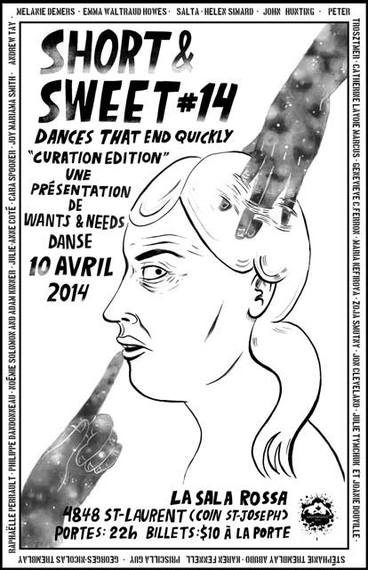 On April 10, Wants&Needs Danse will be presenting the 14th edition of their popular Short&Sweet series in conjunction with the Art Curator's Association of Quebec's "Envisioning the Practice" conference, which looks at Performing Arts Curation. For the occasion, here is an interview that had been conducted with organizers Sasha Kleinplatz and Andrew Tay for the 7th edition of Short&Sweet. SYLVAIN VERSTRICHT: I've been thinking about [Short&Sweet] in terms of artistic direction and, given the high number of choreographers that get to show work, that maybe the best artistic direction is to have none at all. How do you choose who is going to present work? SASHA KLEINPLATZ: I think what we do is try to get people who represent different parts of the contemporary dance community in Montreal. Basically, we will try to make sure we have artists who are young, mid-career, and established. We also try to have a balance between different types of work, i.e. artists who create more cerebral or conceptual work versus artists who create work that is very movement based. We also try to include some artists who aren't necessarily working in the contemporary dance milieu; for example, we have asked clowns, performance artists, hip hop choreographers and puppeteers in the past. I think as curators we believe our challenge with Short&Sweet is community building and creating dialogue. At the same time we try to ask people who we think would make good use of this particular kind of performance situation. SYLVAIN: It also seems that, even though the Montreal dance community is rather small and everyone knows each other, there is still a bit of a divide between francophone and anglophone artists. Short&Sweet is one of the few times when I feel like that line gets somewhat erased. Am I wrong in assuming this and is this something that's important to you? ANDREW TAY: It is definitely something that we think about, and we feel like this is part of what makes Short&Sweet fun and interesting. Homogeny can definitely be boring and every good party needs a good mix of people. I think that we are trying to breed a curiosity among artists to see all the different types of dance ideas that are out there no matter where they are coming from. This curiosity creates an atmosphere that transcends boundaries such as language... We also think this situation is really unique to Montreal and important! I was at a symposium recently that was talking about the so-called anglo - franco culture divide and some people were arguing that a bilingual audience doesn't exist. I totally disagree with this and I think events like Short&Sweet prove it is an exciting possibility. I think we are lucky since dance is not necessarily a language-based art form and because of this we have more opportunity to cultivate this kind of audience. SYLVAIN: For this edition of Short&Sweet, you asked choreographers to collaborate with artists from other disciplines. Dance always strikes me as being particularly collaborative, so I was wondering how this constraint concretely affected your piece this time around… SASHA: I know for me it felt like an opportunity to take a chance with collaborators I have never worked with before. Because the piece is short I felt comfortable treating the collaboration as a blind date between myself and the two collaborators and interpreters (musician John Milchem, performance artist Adriana Disman, and interpreters Nathan Yaffe and Susan Paulson). We have all agreed that the process of the collaboration is as interesting as the outcome/performance. We were all just excited to see what working together yields. For me this goes back to the original spirit of experimentation and risk-taking that I was looking for when Andrew and I conceived of Short&Sweet. Short & Sweet #14 April 10 at 10pm La Sala Rossa https://www.facebook.com/events/371765872964691/?fref=ts Tickets: 10$ 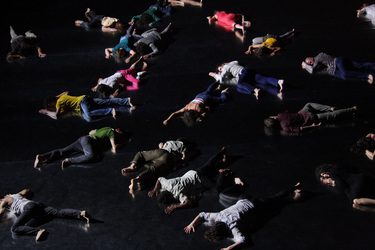 Levée des conflits, photo by Caroline Ablain Levée des conflits, photo by Caroline Ablain As my years as a dance critic pile on, it’s probably to be expected that I see more and more works I’ve already seen. This year, I can think of at least five off the top of my head. The one that most stood up to a repeat viewing was Matija Ferlin and Ame Henderson’s The Most Together We’ve Ever Been. I took the bus to Ottawa to see it just as a snowstorm was hitting the city. The ride ended up taking four hours. I barely had enough time to shove some of the worst food I’ve ever had in my mouth before running over to Arts Court, an old courthouse that has been turned into a beautiful art space. And, as soon as the show started, I knew it was all worth it. Back in Montreal, Israeli choreographer Sharon Eyal made a much-anticipated return after six years with Corps de Walk, a show she created with her partner Gai Behar. The uniformity she imposed on the twelve dancers of Norway’s Carte Blanche was oppressive and disturbing. It was its own indictment of homogeneity. At the Biennale de gigue contemporaine, the always reliable Nancy Gloutnez stood out yet again. With Les Mioles, she borrowed from classical music and became a conductor, turned her dancers’ feet into instruments, and composed a score reminiscent of Steve Reich in its obsessive build-up. After years of being one of the most rigorous emerging choreographers in Montreal, Sasha Kleinplatz has now fully emerged with Chorus II. The audience stood above six male dancers who swayed between demonstrations of physical strength and chill-inducing vulnerability. It is now up to venue artistic directors everywhere to shine on Kleinplatz the spotlight she so clearly deserves. Speaking of which, 2013 was the year of Agora de la danse. They probably had their best programming since I started following dance. It all began with Karine Denault’s Pleasure Dome, in which musicians and dancers explored pleasure without ever lazily resorting to shortcuts. Rather, she allowed the meaning of the work to emerge on its own and for Pleasure Dome to impose itself by the same token. It was followed by When We Were Old, a duo by Québec’s Emmanuel Jouthe and Italy’s Chiara Frigo (presented in collaboration with Tangente). The choreographer-dancers managed to bypass every single contemporary dance cliché that usually occurs as soon as a man and woman are onstage. In each and every moment, their encounter felt fresh and sincere. Agora ended the year with Prismes by Benoît Lachambre, who a month later would win the Montreal Dance Prize. Created for Montréal Danse, Prismes explored the effect of light on perception in a chromatic environment, as well as the fluidity of gender. Lighting designer Lucie Bazzo outdid herself for this highly experiential work. At the Festival TransAmériques, it was French choreographer Boris Charmatz who stood out with Levée des conflits, an opus of twenty-five movements repeated as a canon by twenty-four dancers. From the simplicity of the choreography to the high number of performers, Levée des conflits impressively hovered between minimalism and excess. I spent the summer in Iceland, where my trip ended with the Reykjavík Dance Festival. There, Norway’s Sissel M Bjørkli presented one of the most singular shows I’ve ever seen with Codename: Sailor V. It took place in a tiny space, barely big enough to seat fifteen. The smoke that filled the room along with Elisabeth Kjeldahl Nilsson and Evelina Dembacke’s intensely saturated coloured lighting blurred the edges of everything. Inspired by anime, Bjørkli created an alter ego for herself and through imaginative play managed to turn an office chair into a spaceship. That shit was magical. So was Nothing’s for Something by Belgium’s Heine Avdal and Yukiko Shinozaki, which opened with a ballet for six curtains, each suspended by six huge helium-filled balloons. Set to classical music, it was reminiscent of Disney’s Fantasia. For its finale, eight such balloons were left to float around the room while emitting breathing sounds, appearing like disembodied alien visitors. Soon after my return to Montreal, Marie Chouinard presented Henri Michaux : Mouvements. The genesis of this work, when Carol Prieur first incarnated the drawings of Henri Michaux back in 2005, is the reason why I’m a dance critic today. Seeing the twelve dancers of Chouinard’s company lend themselves to the exercise was just as riveting eight years later. By translating drawings into movement, Chouinard demonstrated the power of dance to think the body creatively. Usine C ended the year on a high note with their program from the Netherlands, most especially Ann Van den Broek’s feminist work for three female dancers, Co(te)lette. The show was powerful in its exposition of women’s bodies as a site of tension, torn between being objects of desire and embodied subjects. We can only hope that there will be more works like it in 2014. 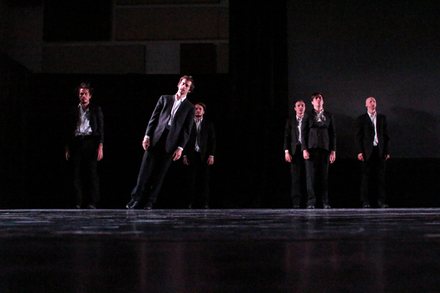 Chorus II, photo by Jasmine Allan-Côté Chorus II, photo by Jasmine Allan-Côté Sylvain Verstricht 12 Apr (4 days ago) to sasha Hi Sasha, Would you want to talk to me about your new show? Do you have time? (Preferably by email, but we could do it in person if need be. Or maybe even chatting?) I hope all is well. xo Sash 12 Apr (4 days ago) to me Hey, Email is great:) Cheers Sylvain Verstricht 12 Apr (4 days ago) to Sash You went from a "man free zone" in your last work [All the Ladies] to an all-male cast for your new show, Chorus II. Why the switch? sasha kleinplatz 13 Apr (3 days ago) to me I think it had to do with the subject matter (davening), which I remember my grandfather performing. He was a really tough guy, but when he prayed he could be so tender and meditative. I was interested in exploring that "energy" with a group of male dancers, as a way of remembering and re-writing my experiences of him. Sylvain Verstricht 13 Apr (3 days ago) to sasha Your performers come from a variety of backgrounds: different schools; some are barely out of them, others have been dancing professionally for a while... It almost seems as though you handpicked them. Why these particular men? sasha kleinplatz 13 Apr (3 days ago) to me When I first started working on this piece it was for Piss in the Pool, and I knew I wanted as many men as possible. I wanted it to be a counter-point to the twelve-women choreography I made for the pool two years earlier. I basically wrote every male dancer I knew, as well as a bunch I barely knew who were recommended to me by friends. Anybody who said "yes" was in the choreography (not the most professional method but it worked amazingly). Most of those original dancers are still in the work. Sylvain Verstricht 14 Apr (2 days ago) to sasha Since you bring it up, you have been working on it for a while... I always admired you for your rigor, so I have to ask: how do you manage to maintain interest in one piece for such a long period of time? How has it changed over time? sasha kleinplatz 14 Apr (2 days ago) to me Oh man, it is hard to stay rigorous! It isn't hard to stay interested, but it's hard to stay committed to the thread of the work and not diverge into ideas that are outside the particular choreography I am making. It helps to have collaborators who can also see the themes of the work pretty clearly; they keep you on track. The interpreters (Benjamin Kamino, Milan Panet-Gigon, Nate Yaffe, Lael Stellick, Simon Portigal, and Frédéric Wiper) are amazing for this, they all have their own experience and perceptions of the work, and if they feel like we have strayed too far from the universe we have created they will tell me. Working with a perceptive outside eye is also really integral. For this piece I have worked with three (Thea Patterson, Andrew Tay, Ginelle Chagnon), all of whom have pushed me to retain and clarify the voice of the work. It also helps to be feel a bit possessed by the work:) Sylvain Verstricht 14 Apr (2 days ago) to sasha During the public performance following your residence at Usine C, one of the dancers let his partner fall a bunch of times. Based on their interaction after the show, I assume that wasn't supposed to happen. Question: have you been experiencing massive amounts of guilt or was it their own fault? sasha kleinplatz 14 Apr (2 days ago) to me That's a hilarious question. Um, no I don't feel guilty. I am a pretty paranoid choreographer, I am constantly asking the dancers if a movement feels safe to them to execute, to a degree that the dancers have point-blank told me is very annoying. So, I had asked them about that part repeatedly before the showing, and afterwards when I asked the dancer if he was okay he basically laughed at me. Sylvain Verstricht 15 Apr (1 day ago) to sasha One last question... After you presented Chorus II at Piss in the Pool, I compared it to Édouard Lock's work (mostly just because of the black suits the men wore). I used the word "emptied" ("un Édouard Lock vidé de ses muses féminines"), which I now realize sounds pejorative, but I really meant it as a compliment. Do you hate me? sasha kleinplatz 23:44 (15 hours ago) to me No, I love you, you know that. I was kind of like "fuck, my work looks derivative!" but that's okay. Can't let Locke corner the market on men in suits. Anyways, it's all good, we are good:) April 18-20 at 8pm & April 21 at 3pm MAI www.m-a-i.qc.ca 514.982.3386 Tickets: 22$ / Students: 15$ 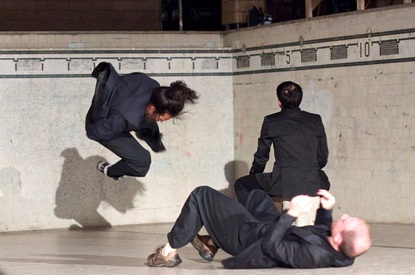 Sasha Kleinplatz's Chorus Two..., photo by Celia Spenard-Ko Sasha Kleinplatz's Chorus Two..., photo by Celia Spenard-Ko À la sortie de Piss in the Pool, que retient-on cette année? Surtout Flotsam, la pièce de Leanne Dyer pour laquelle les cinq interprètes sont cachés sous d’imposants costumes composés de centaines de sacs de plastique. Trois grosses boules couleur vert menthe – les sacs du Supermarché PA – mais dont la couche s’avère être gracieuseté du Jean-Coutu, et deux chenilles de plastique, une blanche et l’autre noir (on se tient ici dans la palette limitée de Glad). C’est un défilé de mode, c’est un rituel consommateur, mais c’est surtout un petit monde étrange et aux images marquantes. On remarque aussi la rigueur que la chorégraphe Sasha Kleinplatz amène à tous ses projets avec Chorus Two… Après s’être entouré de femmes pour All the Ladies, c’est maintenant sur cinq hommes qu’elle projette son travail toujours très physique. Avec leurs complets noirs, les danseurs font penser à un Édouard Lock vidé de ses muses féminines. La New Yorkaise Shannon Gillen offre une introduction à la soirée qui nous plonge immédiatement dans un univers inquiétant avec WOLFMAN Redux. Le visage de la seule danseuse au fond de la piscine est recouvert de papier métallique. Son mouvement reflète le désarroi et l’anxiété que pourrait causer un manque d’oxygène. Ces trois pièces se retrouvent toutes en première partie, alors on peut deviner que la deuxième n’est pas tout à fait du même calibre. Toutefois, il y a Manuel Roque qui se démarque avec trou (pour deux) (à capella), un duo aux airs de compétition sadique qu’il danse avec Lucie Vigneault. Piss in the Pool 2011 18 juin à 20h30 Bain Saint-Michel, 5300 Saint-Dominique www.montrealfringe.ca 514.849.FEST (3378) Billets : 12$ |
Sylvain Verstricht
has an MA in Film Studies and works in contemporary dance. His fiction has appeared in Headlight Anthology, Cactus Heart, and Birkensnake. s.verstricht [at] gmail [dot] com Categories
All
|
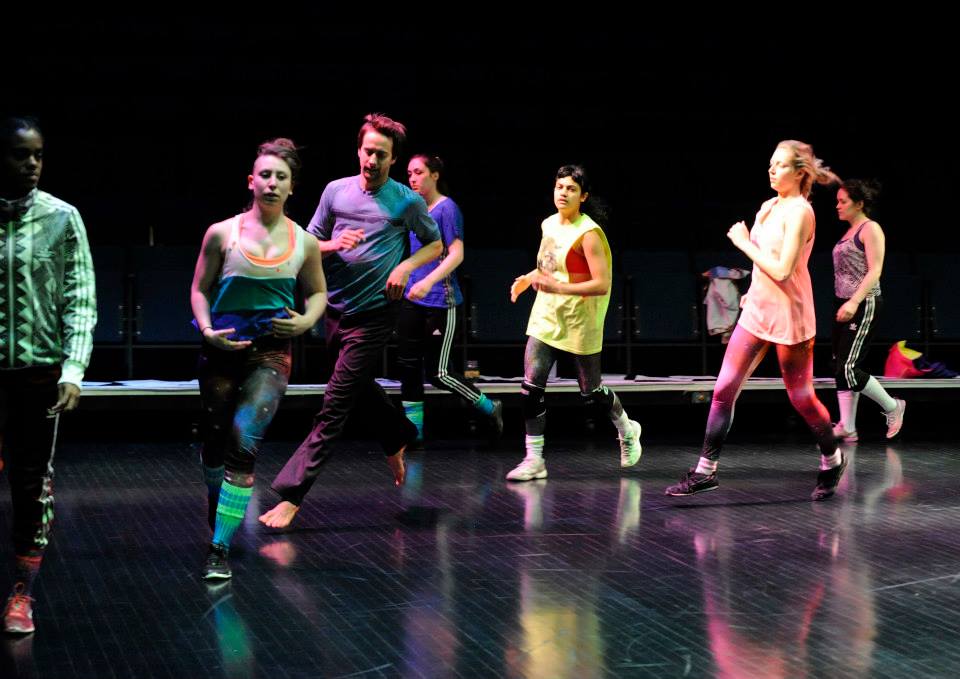
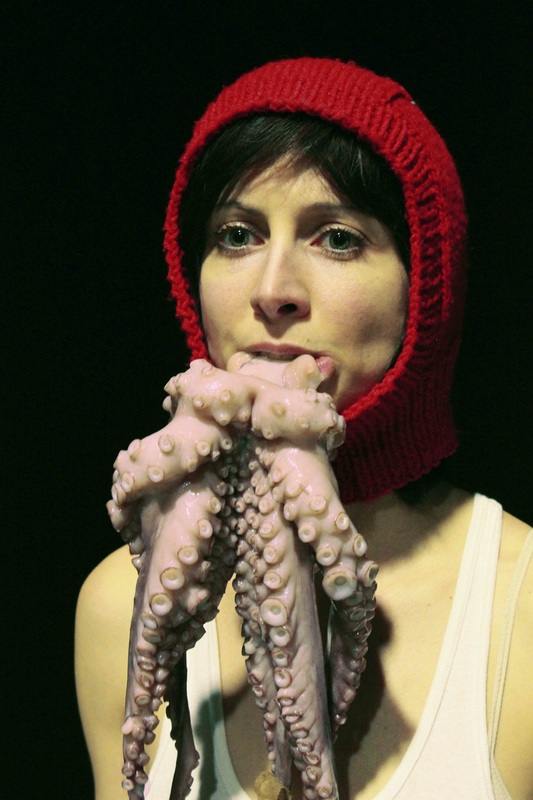
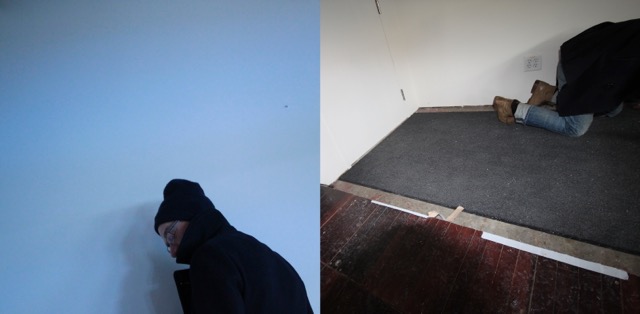
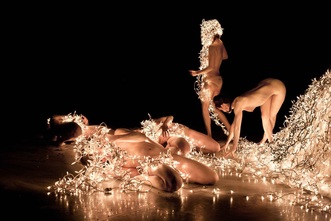
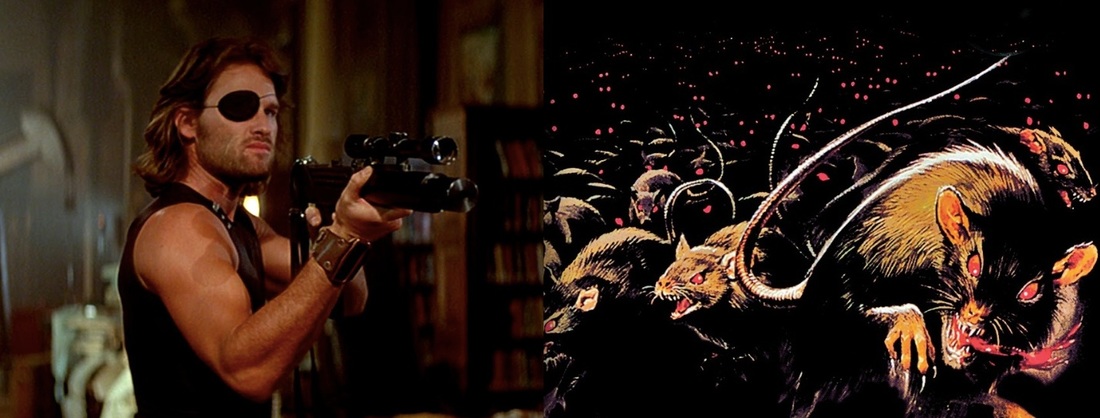
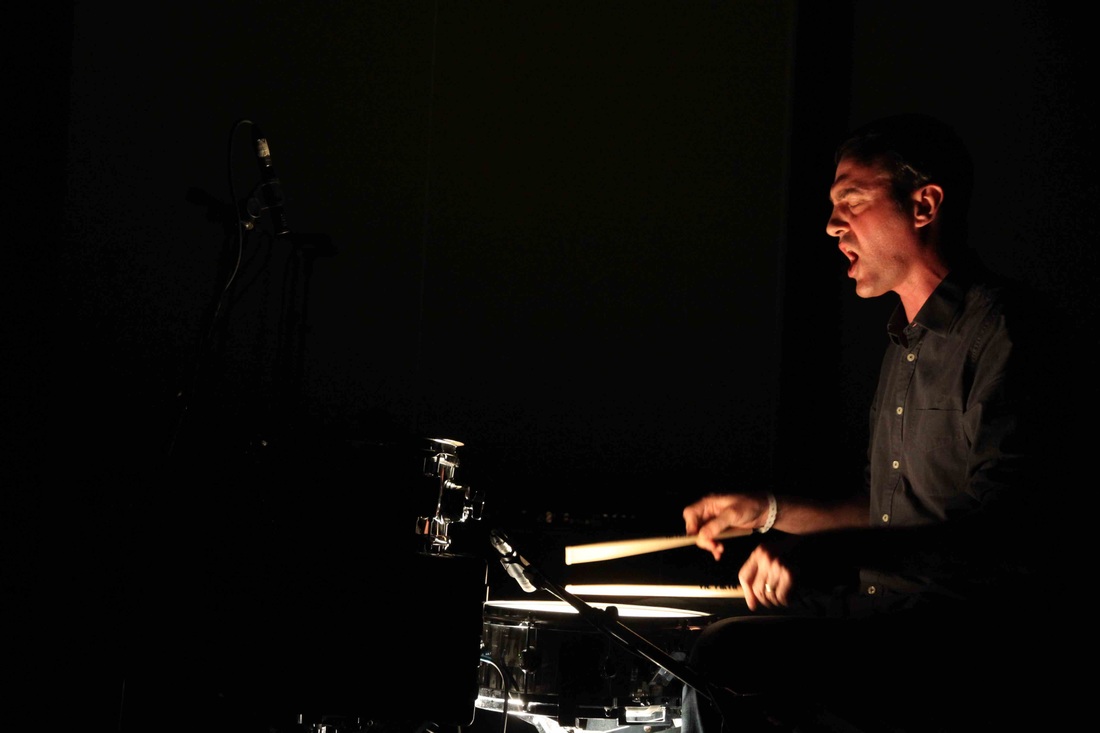
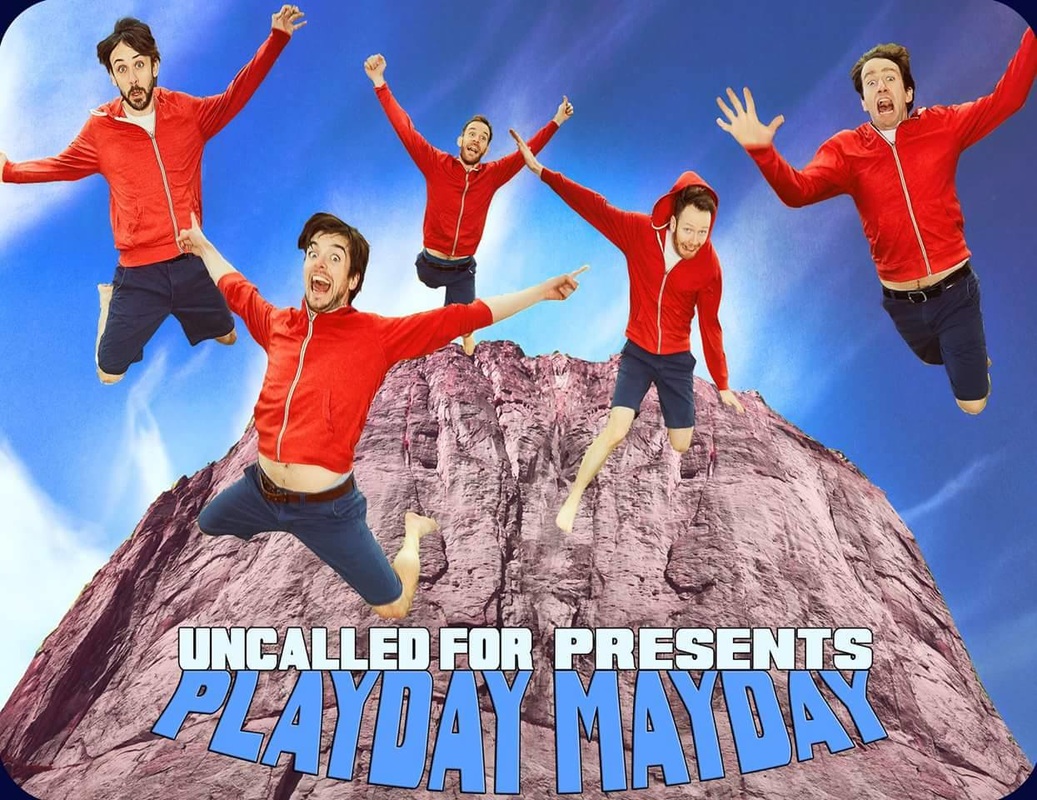

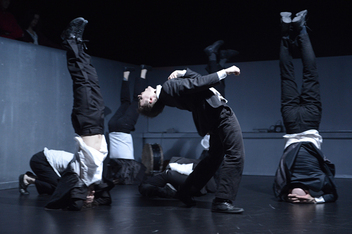
 RSS Feed
RSS Feed